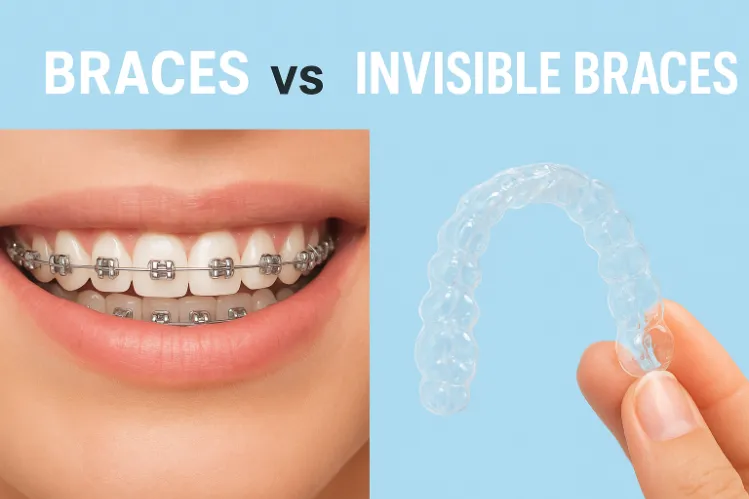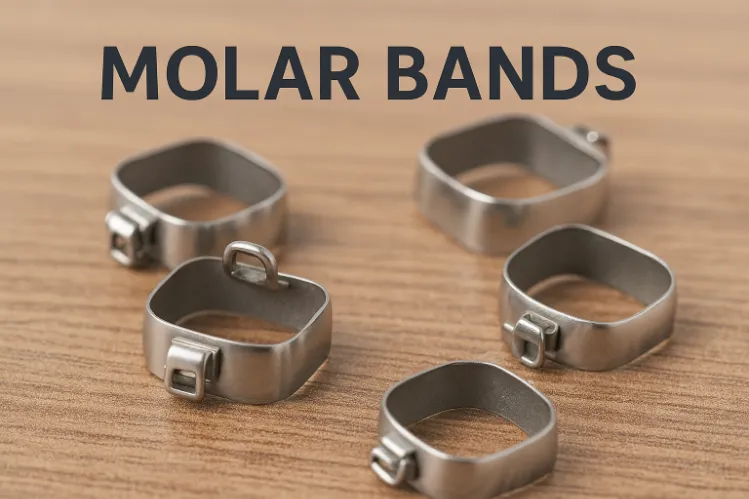
When it comes to straightening teeth, the debate of braces vs invisible braces is one almost everyone faces. Both options improve your smile and dental health, but the way they work, feel, and look can be very different. If you’re unsure whether to choose metal braces, clear braces (ceramic braces), or invisible aligners like Caspersmile , this guide will help you understand the pros, cons, and key differences.
Braces are one of the oldest ways to straighten teeth, and even today, they are still really common because they work so well. They are made of small brackets that stick to your teeth and are connected with wires. Most people get metal braces, but there are also ceramic ones if you want something that doesn’t stand out too much.
Pros of Braces:
Cons of Braces:

Invisible braces usually refer to clear aligners, such as Caspersmile, which are custom-made plastic trays that gently move your teeth. They are removable, discreet, and much more comfortable for many patients compared to fixed braces.
Pros of Invisible Braces (Clear Aligners):
Cons of Invisible Braces:

Are aligners better than braces? Not really. They both have their benefits, but there are some main differences between these two treatments. Let's discuss them one by one.
| Comparison | Key Difference |
|---|---|
| Metal braces vs Clear aligners | Metal braces are better for handling complex orthodontic issues, while clear aligners provide comfort and are almost invisible. |
| Clear braces vs Clear aligners | Clear braces are fixed to your teeth and slightly noticeable, whereas clear aligners are removable and virtually invisible. |
| Ceramic braces vs Clear braces | Ceramic braces are tooth-colored and blend with your teeth, while clear braces use transparent brackets for a subtle look. |
| Lingual braces vs Aligners | Lingual braces are hidden behind the teeth but can be harder to clean and adjust, while aligners are easier to manage and discreet. |
This answer depends on your personal needs. For example, if you only need minor corrections or are looking for discreet methods of teeth straightening, clear aligners are the perfect option . But if your case is complex and needs more regular supervision, braces are more suitable for you. Some orthodontists will even combine multiple methods to achieve your perfect results.
Choosing between traditional braces and invisible braces really comes down to what matters most to you: your lifestyle, budget, and dental needs. Braces are still a dependable option for more complex cases, while clear aligners give you the freedom, comfort, and subtle look many people prefer, and at the end of the day, the right choice is the one that aligns with both your smile goals and your everyday routine.




Curated the best for your knowledge
.png) Metallic Taste in Mouth: Causes and How to Get Rid of It
Metallic Taste in Mouth: Causes and How to Get Rid of ItHaving metal taste in the mouth first thing in the morning can be an unexpected experience. You wake up, take a swallow, and suddenly have a metallic taste in your mouth, as if you'd been chewing on a handful of change. It's annoying, a little scary, and sometimes for no apparent reason. For some people, it will be nothing but a minor nuisance; others may fall into the late-night goose chaser. Sometimes it's a sign that there is something wrong with your braces; other times, it could mean that there is something wrong with one of your teeth. But here's the good news: Most metallic tastes are temporary, harmless, and can be treated or resolved. So let's take a closer look at the possibilities.
Read More How Molar Bands Work in Braces and Retainers to Keep Your Teeth in Line
How Molar Bands Work in Braces and Retainers to Keep Your Teeth in LineIf you’ve ever started orthodontic treatment, you already know there are a lot of tiny pieces involved. Wires, brackets, elastics, retainers, attachments… and then there are molar bands. They’re not as famous as braces themselves, but they play a surprisingly big role in keeping your smile moving in the right direction. Some people don’t really notice them. While others desperately want to know why that metal ring is even there. So let’s break it all down: what molar bands are, why orthodontists use them, and how they work in both braces and retainers. Plus, what you should expect throughout the process.
Read More.webp) Dental Bonding Cost: Prices, Process & What to Know
Dental Bonding Cost: Prices, Process & What to KnowIf you’re thinking about fixing a chipped tooth, closing a gap, or smoothing out uneven edges, dental bonding is often the easiest (and quickest) way to do it. And honestly? It’s one of the most budget-friendly cosmetic treatments out there, if you know what to expect. But here’s the part everyone worries about first: “How much does tooth bonding cost?” The short answer: it depends. The long answer: let’s break it all down so you actually understand where the price comes from, what you’re paying for, and whether bonding is the right fix for your smile.
Read MoreQuick Links

Heading